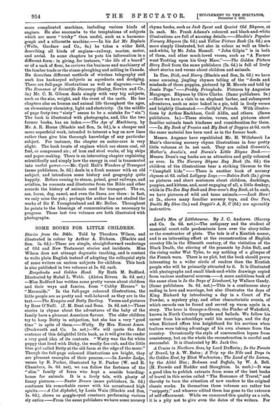Lord's Men of Littlebourne. By J. C. Andrews. (Harrap and
Co. 28. 6d. net.)-The antiquary and the student of manorial court rolls predominate here over the story-teller or the constructor of plots. The tale is of a Kentish manor, and is an interesting effort at the reconstruction of English country life in the fifteenth century, of the visitation of the Black Death, the stirring of the peasants by John Ball, and the rising under Wat Tyler, to say nothing of a glimpse of the French wars. There is no plot, but the book should prove interesting to a wider circle of readers than the Kentish people who will be primarily attracted to it. It is illustrated with photographs and small black-and-white drawings copied from various mediaeval sources.-A more ambitious book of the same class is In the Days of Lionheart, by Wallace Gandy. (Same publishers. 3s. 6d. net.)-This is a continuous story ending in love and marriage, but also illustrates the days of King Richard by introducing a day in a Court of Pie Powder, a mystery play, and other characteristic events, of which records can be found and served up warm again in a story. The hero is George-a-Green, the Pinder of Wakefield, known in North Country legends and ballads. We follow his career from his schooldays until his marriage, and the day when Richard offers him knighthood for his services when traitors were taking advantage of his own absence from the country. Occasionally the style of conversation lapses from consistency, but on the whole the reconstruction is careful and successful. It is illustrated by Mr. Jack Orr.


































































 Previous page
Previous page